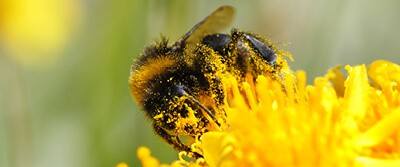Air Pollution Threatens Bees' Quest for Food

By Kylie Wolfe
Beehives are usually thought of as bustling and buzzing epicenters of activity, but newly discovered threats to colonies’ ability to locate food and pollinate plants may be putting an end to that rosy picture. Scientists are uncovering information that points to air pollution as a key factor in the decline of these once busy bee populations.
In the United States alone, honeybee populations have declined from 25 to 45 percent per year since 2010. When air pollutants interact with plant scents, they decrease the distance a scent travels and how long it stays in the air, making it more challenging for forager bees to track down food sources.
The Challenges of Foraging
When a food source is located, bees can transport nectar back to the hive and alert others in the colony that food is nearby. When a female dancer bee returns to the hive, she performs what is known as a “waggle dance” to demonstrate the direction and distance that the other foragers should travel. The dance takes the form of a sideways figure eight shape: the angle of the overlapping segment indicates direction and the length of the dance communicates the distance. But for the waggle dance and other behavioral foraging methods to be worthwhile, the bees have to be able to detect and follow the scent that the dancer bee brings back to the hive.
The Effect on Scent
New simulations at Penn State University have shown that air pollutants react with plant scent molecules and can modify their chemical makeup and odor. The scent changes decrease their concentration, so bees take longer to find food, decreasing their foraging and pollinating efficiencies.
“Each insect has a detection threshold for certain kinds of scents and they find food by moving from areas of low concentrations of scents to areas of high concentrations,” said Jose D. Fuentes, PhD, professor of meteorology and atmospheric science at Penn State.
Research Around the Hive
Normally, scent molecules can last almost 40 hours and reach hives up to 3,000 feet away. In the Penn State study, researchers found that compromised scent molecules survived only 10 hours and traveled fewer than 1,000 feet, so tasks that would normally take foragers 10 minutes actually took 180 minutes to complete. This results in bees taking more time to find less food, decreasing their efficiency and the colony’s ability to survive.
“It's similar to being asked to get a cup of coffee at the nearest cafeteria while you are blindfolded. It will be hard to locate the coffee shop without using visual cues. The same could happen to insect pollinators while foraging for food in polluted air masses,” said Dr. Fuentes.
Environmental Impacts
Over the last 10 years, both the United States and Europe have reported a significant decline in bee populations. In addition to air pollution, scientists are also researching neonicotinoids, agricultural pesticides that may be present at toxic levels. These insecticides are commonly used on fruits, vegetables and some grains and may be contributing to a decrease in the number of queen bees and affecting a bee’s ability to return to the hive.
Scientists warn that our effects on the environment can negatively impact this critical insect that helps to balance our ecosystem. One third of the food we eat depends on pollination, and less pollination may contribute to a decline in plant growth and overall agricultural yield. Our environmental footprint is coming full circle, impacting bee populations and, ultimately, food availability.
Discussion Questions
- How do we determine the location and quality of our food sources? Compare and contrast the foraging behavior of bees with the foraging behavior of humans and other animals.
- What other environmental conditions do you think might be contributing to a decline in bee populations?
- How can people change their current habits to more positively impact the environment?
Vocabulary
- Pollination
- Forage
- Waggle Dance
- Environmental Footprint
